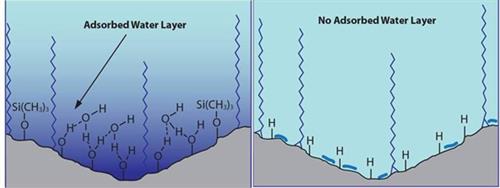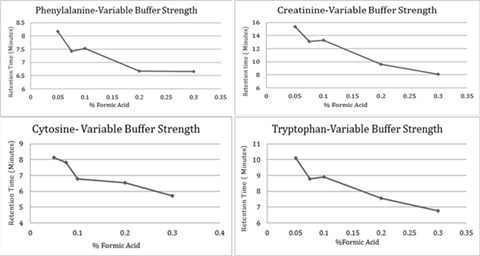Updated 5-JUNE-2025
Improving Polar Compound Analysis: ANP vs. HILIC for LC and LC-MS
Over the years, analytical scientists have faced persistent challenges when developing HPLC and LC-MS methods for highly polar compounds. While Hydrophilic Interaction Liquid Chromatography (HILIC) has been a go-to technique, many chromatographers report significant drawbacks—especially when using gradient methods.
Common HILIC Challenges
- Slow Equilibration: HILIC columns, like conventional silica-based phases, require extended equilibration due to the persistent water layer (hydration shell) on the silica surface. This leads to increased downtime between runs.
- Reproducibility Issues: The hydration shell is sensitive to environmental changes (e.g., temperature), often resulting in poor precision and retention time variability.
- Column Instability: HILIC columns may degrade unpredictably, particularly during overnight sequences.
- High Salt Requirements: Retention often depends on mobile phases with salt concentrations up to 100 mM—problematic for LC-MS systems and preparative workflows due to ion suppression and fouling.
Aqueous Normal Phase (ANP): A Smarter Alternative
ANP chromatography, particularly with Cogent TYPE-C™ silica hydride columns, offers a robust solution. Like HILIC, ANP retains polar compounds using high-organic mobile phases and inverse gradients. However, the underlying chemistry is fundamentally different:
- No Hydration Shell: TYPE-C silica lacks the persistent water layer, enabling faster equilibration (typically 3–5 column volumes).
- Minimal Silanol Activity: With <5% residual silanols and direct Si–C ligand bonding, ANP columns avoid the secondary interactions that plague HILIC.
- Low Salt Operation: ANP methods typically require ≤15 mM salt, eliminating the need for buffers and reducing LC-MS contamination risk.


Key Benefits of ANP over HILIC
- Rapid Equilibration → Higher throughput and reduced solvent use.
- Exceptional Precision → Reliable retention times across runs and days.
- Extended Column Lifetime → Fewer failures and lower replacement costs.
- LC-MS Compatibility → Low salt minimizes ion suppression and system fouling.
- Versatile Selectivity → Retains both polar and some non-polar analytes.
- Simplified Method Development → Broad selectivity range and reproducibility.
Technical Highlights
- Surface Chemistry: Cogent TYPE-C columns exhibit <1 monolayer of water vs. 3–12 in HILIC, improving surface consistency.
- Fast Re-equilibration: 3–5 column volumes vs. significantly longer for HILIC.
- Stable Surface Charge: Silica hydride surfaces are negatively charged due to surface hydroxide ions.
- Dual-Mode Capability: TYPE-C columns can operate in both ANP and reversed-phase modes.
- Low Additive Requirements: Most polar analytes can be retained with ≤15 mM salt—no buffers needed.
For further reading, see:
Kulsing et al., "Insights into the Origin of the Separation Selectivity with Silica Hydride Adsorbents," J. Phys. Chem. B, 2015, 119, 3063–3069.
2. Rapid Equilibration of the stationary phase after gradients, typically in the range of 3-5 column volumes for Cogent TYPE-C Columns.
3. Negatively Charged Surface on Silica Hydride due to free, surface Hydroxide ions.
4. Difference in Selectivity and Enhanced Retention in ANP.
5. Ability of Cogent TYPE-C Columns to Function in Reversed-Phase HPLC Mode.
6. Excellent run to run and column to column Reproducibility with Cogent TYPE-C Columns.
7. No need for high Concentrations of Additives in the Mobile Phase; only 15mM or less required for most Hydrophilic Compound Analyses in ANP.
See also: Main Differences between HILIC & Cogent TYPE-C Columns...
See also: Why ANP HPLC Methods are Better to use than HILIC.
See also: Efficiency of ANP v. HILIC Columns
Reference below for details on this topic published in J. Phys. Chem. B.:
C. Kulsing, Y. Nolvachai, P.J. Marriott, R.I. Boysen, M.T. Matyska, J.J. Pesek, M.T.W. Hearn |
Insights into the Origin of the Separation Selectivity with Silica Hydride Adsorbents |
J. Phys. Chem. B. |
2015 |
119 |
3063-3069 |

Attachment:
Very High Flow Rate, High Efficiency & Selectivity PDF Download File
